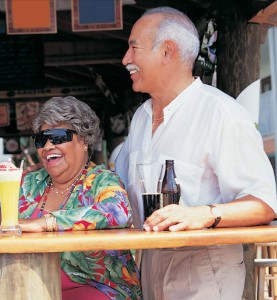 There’s no escaping it: We are getting older as a nation. In 2011, the first of the Baby Boomers reach age 65, and by 2030, more than 70 million Americans will be 65 or older, representing nearly one in five Americans. That figure is twice the number that had reached that milestone in 2000.
There’s no escaping it: We are getting older as a nation. In 2011, the first of the Baby Boomers reach age 65, and by 2030, more than 70 million Americans will be 65 or older, representing nearly one in five Americans. That figure is twice the number that had reached that milestone in 2000.
And just as the effects of the Great Recession continue to be felt, many U.S. communities have fallen behind in making preparations for their aging residents. Even though the recovery has already begun, the recession continues to affect local, state and federal agencies at all stages of policy, programs and planning, as the budget axe continues to fall in municipalities all over the U.S. As a result, at the time when spending on programs and services for aging adults is most needed, it’s being curtailed.
Those are the key findings of a new report, “The Maturing of America—Communities Moving Forward for an Aging Population,” the 2011 follow-up to a similarly extensive survey conducted in 2005. The study was led by the National Association of Area Agencies on Aging (n4a) with the support of partner MetLife Foundation and the International City/County Management Association (ICMA), Partners for Livable Communities, the National Association of Counties (NACo), the National League of Cities (NLC) and the American Planning Association. ICMA administered the study.
“These findings show that the country still has a tremendous amount of work to do in a very short amount of time to address America’s rapidly rising aging population,” says Sandy Markwood, CEO of n4a. Adds Dennis White, President of MetLife Foundation, “This report underscores the importance of addressing the needs of an aging population at the local level. The good news is that there are many actions community leaders can take right away—that don’t require additional resources—to prepare for bolder, more comprehensive services for older citizens.”
Facing Challenges
 The report finds that the recession-driven cuts to local government budgets have impaired the ability of communities to keep up with needed preparations for their aging populations. Many have managed to maintain funding at current levels, but they have not been able to grow programs and services at needed rates to meet the challenges their aging populations present. “Although communities have done an admirable job to maintain the status quo considering the economic conditions we’ve faced, given the dramatic aging demographics, the status quo is not good enough,” Markwood adds. “These findings should be a major wake-up call for local governments and should motivate them to take immediate actions that will address the challenge and opportunities at hand.”
The report finds that the recession-driven cuts to local government budgets have impaired the ability of communities to keep up with needed preparations for their aging populations. Many have managed to maintain funding at current levels, but they have not been able to grow programs and services at needed rates to meet the challenges their aging populations present. “Although communities have done an admirable job to maintain the status quo considering the economic conditions we’ve faced, given the dramatic aging demographics, the status quo is not good enough,” Markwood adds. “These findings should be a major wake-up call for local governments and should motivate them to take immediate actions that will address the challenge and opportunities at hand.”
Communities reported facing their toughest challenges in three areas: financial/funding shortages, transportation and housing. Part of the issue is a decline in growth in many communities. In the new study, only 42% reported experiencing some growth, down from 67% in 2005. Similarly, 30% of local governments reported experiencing some decline, which represents a nearly threefold increase from the 11% that reported the same in 2005.
Specific findings touched on 10 key areas of needed support.
Health Care
More than two-thirds (69%) of local governments surveyed offer health care services that meet a range of needs for their older citizens. Governments in large urban areas are doing exceedingly well in this regard, as all reported having such services available. The big challenge lies with more rural areas, where senior adults are at more of a disadvantage than their urban counterparts.
Nutrition
Congregate and home-delivered meals programs are available in 85% of responding communities, and more than half are provided by nonprofit or faith-based organizations, according to the report. Nutrition education programs are available in 73% of communities.
Exercise
More than 70% report that exercise classes tailored to specific health needs are available, and nearly 90% say that local parks and other facilities have safe, easy-to-reach walking and biking trails. The Pacific Coast region leads the nation in making both types accessible.
Transportation
What is available in terms of providing transportation varies widely by locality. But more than 80% of respondents confirmed they offered programs that offered some level of transportation to and from health care services, as well as other destinations. Three-quarters also have sidewalks and street crossings that are safe and accessible for older pedestrians, although fewer have sidewalks linking residences and essential services.
Public Safety/Emergency
Some 59% of local governments report providing specialized training to public safety and emergency staff to deal with older citizens. That’s more than double the figure from 2005. However, evacuation plans for older adults actually decreased from the earlier survey to the newer one, down 71% from the previous 81%. Also slightly declining are programs to detect and prevent elder abuse and neglect.
Housing
Communities have maintained an availability of programs to provide home maintenance and repair assistance, home modification and targeted service delivery, such as backyard trash collection and sidewalk snow removal, since 2005. But subsidized housing programs declined nationwide, as 63% of communities reported offering these as opposed to 70% in 2005.
Taxation and Finance
Relief from property taxes for older adults on limited income experienced a reported drop from 2005 to now, down to 54% from 72%. Also declining, albeit less steeply, was the availability of programs that educate older adults about financial fraud and predatory lending (down to 65% from 69% in 2005). But there was a slight bump upward in the availability of programs that assist with tax form preparation.
Workforce Development
Another area that continues to lag, workforce skills development services that target older adults, was available in only 48% of responding communities. And only 39% reported offering employer engagement/education programs.
Community and Civic Engagement
Communities reported a significant increase in volunteer opportunities for older adult, up to 80% from 66% in 2005. Also, nearly 90% reported that older adults are represented on advisory boards, commissions or committees that deal with planning issues that have an impact on them.
La nación está envejeciendo rápidamente, según indican los informes…
No hay nada que hacer, ¡nos estamos envejeciendo como nación! En el 2011, los primeros Baby Boomers llegarán a los 65 años, y hacia el 2030, más de 70 millones tendrán 65 años o más, representando la quinta parte de todos los estadounidenses. Esta cifra es dos veces mayor a la de los que alcanzaron este hito en el año 2000.
Y conforme los efectos de la Gran Recesión continúan sintiéndose, muchas comunidades en los Estados Unidos se han quedado atrás en los preparativos para atender a sus residentes que llegan a la tercera edad. Aunque ya ha comenzado cierta recuperación, la recesión sigue afectando las agencias locales, estatales y federales en todas las etapas de la preparación, programación y planificación de políticas, a medida que los recortes en el presupuesto recaen sobre las distintas municipalidades a lo largo del país. En consecuencia, se están recortando las inversiones en programas y servicios para los adultos mayores, justamente cuando más se necesitan.
Estos son los hallazgos más importantes del informe, “The Maturing of America Communities Moving Forward for an Aging Population,” (La maduración de América Las comunidades se movilizan para atender a su población que envejece) el cual es la continuación en el 2011 de una investigación similar llevada a cabo en el 2005.
Aging/Human Services
In-home support services saw a surge upward as 77% of responding communities reported having such services available, up from 71% in 2005. But there was a decrease in the availability of a single-entry point model for services, at 37% (down from 42% in 2005).
Matters of Policy
Communities are also lagging in having plans in place for addressing future needs of older Americans. Only 30% of responding communities reported having procedures for soliciting input from older people, and a mere 17% have comprehensive assessments and strategic plans ready. But 26% reported an intention to conduct an assessment, and 27% reported having such planning in place.
Land use planning is seeing more use in responding communities, however. The master zoning plan is the most commonly available, at 67%, and zoning that supports complete streets was reported by 54% of respondents. That figure drops when it comes to zoning that supports aging in place and active lifestyles for older adults, such as higher-density mixed-use development and amenities. Only 44% of communities reported offering such requirements.
Clearly, local governments will need to find the resources to address the needs of an aging population, and do so sooner, rather than later.










